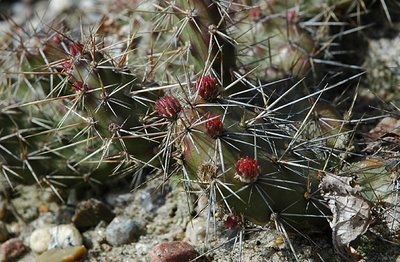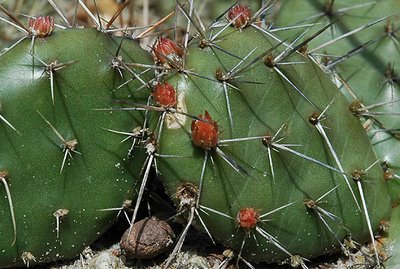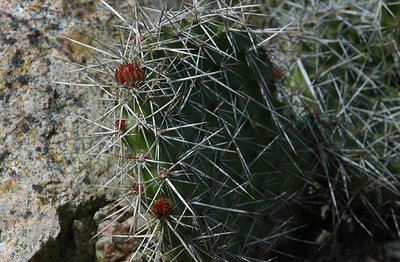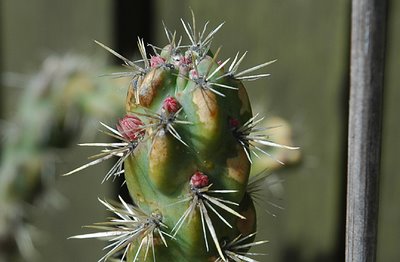As mentioned in the previous post the last month has been extremely wet in Denmark. Some of my plants seem to thrive in the humid environment and are setting new growth while the plants just about to flower haven’t exactly rejoiced in the rain.
Last year I planted 4 Opuntia compressa (Monmouth County, New Jersey) seedlings in one of my beds. The plants were started from seed in 2004 (Mesa Garden described the plants as “cold and wet – no problem” in their catalogue, and they are head-on). The new cladodes are still a fresh lime-green and are bearing reddish-brown leaves.
Opuntia compressa (Monmouth Co, NJ), new growth
At the age of 3 the plants are setting their first flowers – I’m hoping for some sun for the flowers to develop properly.
Opuntia compressa (Monmouth Co, NJ) setting flowers
I’ve had my Opuntia 'Smithwick' plant for several years and it never felt like flowering – until now. Unfortunately many of the flowers haven’t fully developed because of the weather and have ended up as “duds”.
Opuntia 'Smithwick' flower buds ready to flower but withered before they got the chance
Still others have been maimed by gastropods (snails, slugs, what have you) wallowing in the rain.
Opuntia 'Smithwick' flower bud maimed by snails
Thursday, July 19, 2007
New growth and missed opportunities
Friday, April 20, 2007
Budding spring - Rhodiola and Opuntia
My Rhodiola rosea plants are coming out of winter in great shape. A couple of years ago I collected a handful of rhizomes from habitat in Greenland and now grow the plants in an unprotected bed along with my hardy cacti. The Rhodiola rosea plants originate from the hills above Hospitalsdalen (Hospital Valley), a place named after an American military hospital built in connection with the Bluie West One airfield during the 2nd World War. The hills are situated a few kilometers north east of Narsarsuaq and from the top you have a direct view of the Greenland Ice Sheet – I guess the location says it all regarding the plants cold tolerance ;-)
Rhodiola rosea (Narsarsuaq, Greenland)
I’m a bit curious as to whether I have both male and female plants; when I dug up the rhizomes I didn’t know the plants were dioecious, so even though they were flowering at the time I didn’t pay attention to their sex.
Allegedly Rhodiola rosea is categorized as an adaptogen with various health-promoting effects (like e.g. Panax ginseng), but I have no experience with these aspects of the plant.
My Opuntias are also breaking out of dormancy and beginning to set new growth, as illustrated by the pictures below.
Opuntia tortispina (DJF 1139; west Albuquerque, New Mexico)
Opuntia hystricina (DJF 1138; Bernalillo County, New Mexico)
Monday, May 15, 2006
Opuntia and Cylindropuntia – new growth
After a couple of weeks of almost summer-like temperatures in Denmark the Opuntia species growing in my unprotected bed has resumed growth.
The ever trustworthy Opuntia 'Claude Arno' cultivar is bursting with budding cladodes.
Opuntia 'Claude Arno'
Opuntia 'Smithwick' is also a survivor, coming out of winter dormancy with great vigor.
Opuntia 'Smithwick'
My Opuntia polyacantha also lived through winter without damage.
Opuntia polyacantha
Finally the Cylindropuntia imbricata plants growing in pots protected from the worst precipitation are much better off than the C. imbricata in the unprotected bed.
Cylindropuntia imbricata


